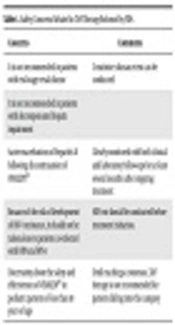Dear Editor,
In spite of the availability of a prophylactic vaccine for more than two decades, infection with hepatitis B virus (HBV) has remained a serious global public health problem. After the significant advancements in the worldwide eradication of hepatitis C virus (HCV), it is believed that the eradication of hepatitis B is also possible (1). However, despite the several attempts toward the elimination of hepatitis B, no cure is available for chronic HBV (CHB) infection (2, 3).
There is enough evidence to support the critical role of CHB infection in the induction of cirrhosis and hepatocellular carcinoma (HCC). Thereby, the ultimate goal of HBV treatment is to prevent cirrhosis, as well as HCC. Although different strategies based on the manipulation of immune responses through combination therapies have been suggested, monotherapy with nucleos (t) ide analogues (NAs) has remained the gold standard for treating CHB (2, 4). Currently, different NAs have been approved for this aim, which could suppress HBV DNA and normalize liver enzymes (5). Because of the risk of drug resistance following exposure to some of these NAs (e.g., lamivudine), tenofovir disoproxil fumarate (TDF) is frequently used as the first-line treatment of CHB in several countries. Although an acceptable suppression of viral load and normalization of liver enzymes could be achieved, it may cause renal toxicity (e.g., renal dysfunction, Fanconi syndrome) and decrease bone mineral density (5). After the emergence of these safety concerns, many efforts were made to introduce a safer treatment for CHB. Accordingly, tenofovir alafenamide fumarate (TAF) was presented, which has demonstrated success in the clinic for the treatment of CHB (6). Following designing two different phase 3 trials for evaluating the efficacy and safety profile of TAF therapy in HBeAg-negative and HBeAg-positive CHB patients (7, 8), it was found that the efficacy of TAF was not inferior to that of TDF. However, this new drug has significantly improved bone and renal safety as compared to TDF. Finally, VEMLIDY® was approved by the FDA on November 10, 2016 (9); and it was recommended that VEMLIDY® be used orally at the dose of 25 mg/d. According to the last evidence, TAF seems as effective as TDF for the treatment of CHB, with continued improvement in renal and bone safety (10). Although no dosage adjustment is required for renal or hepatic impairment, using this drug in those with end-stage renal disease or decompensated hepatic impairment is not recommended (11). Some other crucial warnings released by FDA are summarized in Table 1.
| Concerns | Comments |
|---|---|
| It is not recommended in patients with end-stage renal disease | Creatinine clearance test can be conducted |
| It is not recommended in patients with decompensated hepatic impairment | |
| Acute exacerbations of hepatitis B following discontinuation of VEMLIDY® | Closely monitored with both clinical and laboratory follow-ups for at least several months after stopping treatment |
| Because of the risk of development of HIV-1 resistance, it should not be taken alone to patients co-infected with HBV and HIV-1 | HIV test should be conducted before treatment initiation |
| Uncertainty about the safety and effectiveness of VEMLIDY® in pediatric patients of less than 18 years of age | Until reaching a consensus, TAF therapy is not recommended for patients falling into this category |
Safety Concerns Related to TAF Therapy Released by FDA
Several attempts with the goal of discovering the ambiguous aspects of TAF have been made (7, 8, 12) while there are various dark points, which should be cleared as soon as possible. Regarding the efficacy of TAF at the dose of 25 mg/d and TDF at the dose of 300 mg/d, no significant differences have been found in the capacity of viral suppression. Moreover, the rate of HBeAg loss or seroconversion did not significantly differ. High resistance barrier is another common feature of these two NAs. Patients exposed to either TAF or TDF might experience some adverse reactions with no significant difference, including nasopharyngitis, upper respiratory tract infection, and headache, in order of frequency. In contrast, it was suggested that TAF is more capable of liver enzymes normalization (12). Moreover, TAF is associated with a significantly higher renal and bone safety profile as compared to TDF (8, 10). However, several other important topics, such as the capability of TAF in preventing the progression of CHB to cirrhosis and HCC need more studies. More importantly, no human data are available regarding the possible outcomes of exposure of pregnant women to TAF. In fact, maternal and fetal pregnancy outcomes in TAF-exposed pregnant women are critical, which in contrast to several other anti-viral treatments, have not been addressed yet by any human study (13). In the animal studies, TAF was administered orally to pregnant rats, which was resulted in no adverse embryo-fetal effects (11). It is a positive signal, which encourages us to design human studies. Moreover, due to the risk of HBV reaction following immunosuppressive therapies, we need better insight into using TAF as prophylaxis in inactive HBV carriers, occult HBV, or even resolved patients, who consume immunosuppressive agents, with the high risk of HBV reactivation (14). The most commonly reported high-risk agents include corticosteroids, anthracycline, anti-CD20 drugs, and anti-TNF agents, which are suggested to manage with a high barrier to resistance antiviral, such as TDF (14).
Taken together, TAF (VEMLIDY®) is a more useful and probably safer drug than TDF for the treatment of CHB. However, further studies need to be designed for evaluating the long-term efficacy and safety outcomes in patients with special conditions, such as pregnant women.
